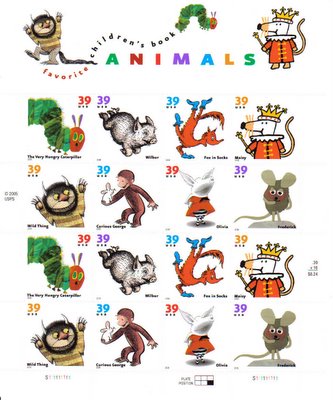Favorite Children's Book Animals


Issued: January 10th, 2006
Children and adults alike will delight in these lively and colorful Favorite Children's Book Animals stamps, two of which - The Very Hungry Caterpillar and Maisy - will also be issued by Royal Mail in the United Kingdom.
Featuring what has become author and illustrator Eric Carle's signature style of painted tissue paper collage, The Very Hungry Caterpillar (1969 and 1987) tells the story of one unusual caterpillar who eats his way through a variety of foods during the course of one week. When he is full, he builds a cocoon around himself from which he emerges as a beautiful butterfly!
In Maisy's ABC - published in the United Kingdom in 1994 and in the U.S. in 1995 - Maisy the mouse discovers that the best way to learn the alphabet is to experience it firsthand. The image on the stamp of Maisy dressed as a queen to teach readers about the letter "Q" demonstrates the bold outlines, bright colors, and simplicity that help endear the books of author and illustrator Lucy Cousins to children.In 1941, Margret and H.A. Rey introduced American readers to a charming and mischievous monkey named Curious George and his light-hearted philosophy that the world is full of discoveries waiting to be made. In Curious George Flies a Kite (1958), George begins his high-flying adventure by visiting the large family of rabbits in the big garden down the road. Whether it is painting the walls like a master, planning the perfect accessory for an outfit, or building an ambitious sandcastle, Olivia is always the star of her own show (and sometimes has too much energy for her own good!). Published in 2000, Olivia won a Caldecott Honor the following year and was author and illustrator Ian Falconer's first book to chronicle the energy and spunk of this loveable and unforgettable piglet heroine. Falconer's spare charcoal line drawings, accented with splashes of red gouache, emphasize the details in the world of his young star.Maurice Sendak's book Where the Wild Things Are (1963), won the Caldecott Medal in 1964 and instantly engages young children. They are carried away to an imaginary land "Where the Wild Things Are."Making new friends can be difficult. But when Wilbur the pig meets Charlotte the spider, he knows that his lonely life in the barn will end. Charlotte's love teaches Wilbur about loyalty, bravery, and the joy of being alive. Illustrator Garth Williams gave form to this inspiring and humble character in E.B. White's Newbery Honor-winning book Charlotte's Web (1952).Leo Lionni's use of torn paper collage and his celebration of nature, creativity, and kindness helped his book Frederick (1967) win a Caldecott Honor in 1968. As a field mouse, Frederick should be preparing for winter like the rest of his family by collecting corn and wheat. Instead Frederick gathers together the colors and words that make cold, dark days feel warm and bright.First published in 1965 by Dr. Seuss, the pen name of Theodor Seuss Geisel, Fox in Socks features a playful and tricky red fox in bright blue socks. As flexible as a gymnast and with a head full of rhymes, he leads beginning readers on a rollicking, tongue-twisting romp through a vibrant world of blue goo, tweetle beetles, and cheese trees.


0 Comments:
Post a Comment
<< Home